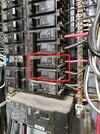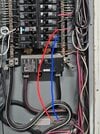This is to the OP,
@MaodouY168. You've mentioned a couple of times that you're not an electrician. It also appears that you're taking what we, here, collectively, believe is Bad Advice, as, "These people are electricians! Of course they're right!"
I'm a EE. I'm about to give you The Basics. Because, and I Am Not Kidding, not following the Basics means you can end up with the house burning down around your ears. Again, I am Not Kidding. And, even if you, personally, don't care about the risks, if you have nearest and dearest in your house, how do you feel about risking
their lives?
First, let's hit up Ohm's Law. This is the guy who pretty much figured out the rules of how current, voltage, and resistance work. In case you missed it or forgot (easy to do if (a) it didn't get covered in elementary school or (b) it's been years since you did see it), the equation is:
Volts = Current * Resistance.
There's another equation, for Power. Power is measured in Watts. Power = Voltage * Current. When power is dissipated in something, that something gets Hot. Take a 100W Lightbulb. It's dissipating 100W. About 5% or so is converted into visible light; the rest goes to heating up the bulb and the area around it. Touch the bulb and you'll get a reflex action, or your finger will get burnt.
Let's follow this a bit more. When that bulb is operating, it radiates (besides the light) heat; further, cool air next to the bulb gets warmed, rises, and carries the heat away. If the radiative (think: Infrared) heat and conducted (through the air) heat did not get carried away, pretty soon the bulb would get warmer, warmer, and things would start burning. There's a reason that on lamps there are little stickers that say, "50W max", or "150W max", and so on: Go higher than what that sticker says, and you'll either get an early death of the bulb (most likely) if you're lucky. If you're not lucky, the insulation in and around that lamp will, by gum, get hot enough to burst into flames. Which, if you're even luckier, what with insulation on the
wires being flammable if it gets hot enough, will cause the lamp wires to touch each other, causing ridiculous current and, hopefully, popping the breaker and Saving The House. And you.
OK. Say one has a hank of copper wire. Wire has resistance. The smaller the gauge of the wire, the smaller the resistance.
Here's a link. Now, suppose you have lamp-grade wire, 18Gauge, and 20 feet of it. From the table, that's 4.61 Ohms/1000', or, for that hunk of wire, 4.61 mOhms to the lamp from the socket, and 4.61 mOhms from the socket to the lamp, for, in this circuit, in that lamp cord, 9.22 mOhms. Now, let's suppose you have a 10A load - like, say, from a vacuum cleaner or something.
Well, Ohm's law says the Voltage Drop Across That Wire is 9.22e-3Ohms * 10A = .0922V. Since we got the current, then, the power is
Power = 0.0922V * 10A = 0.922W.
There's an easier way to handle this, though: V = A * R; P = A * V; then, V = P/A. Substitute that into V = A * R and we get P/A = A*R or, P = A*A*R, the old, "Amps Squared" number. We get 10*10*0.00922 = 0.922W, same number.
So, remember that we have 20 feet of wire. 1W per 20feet gives of 0.05W/foot. Interestingly, if you make this wire, say, five times longer and keep the current the same, it'll
still be 0.05W/foot.
Fine. That's the basics of power. Now, let's look at running Big Current through Copper Wires. Here's a table:
First column is the wire gauge size, and, going down, those ones with 250 or greater are monsters. But let's pick, I dunno, 8 GA wire. All the numbers to the right is how much current said gauge wire can carry. But.. why are there so many columns?
Those letters, like NM-B, THW, THWN-2 refer to commercial standard types for those wires. This tend to be based upon two things:
- The insulation being used.
- Where the wire is being installed.
Let's talk about the second item, first. Just Like That Light Bulb, Copper Wiring Carrying Current Dissipates Power. That Makes The Wire Get Warm. The Heat Has To Have Someplace To Go, or It's Going To Get Hot Enough To Char The Insulation. And, possibly, Set The House On Fire.
Say you have wire routed through the drywall, like everybody else around here. People with PhDs, thermocouples, doing standard building practices, and Sweating The Last Bunch Of Houses That Smoked, have done Serious Research which hath ended up in the National Electric Code.
8 Ga wire that's installed in a flat package surrounded by electrical insulation that's good for a certain temperature and gets installed in drywall gets one amperage number. 8 Ga wire that goes into plastic conduit, where the wires are separated from each other, gets a higher number. If the conduit is
metal, that conducts heat better, so the current levels can be even higher.
In short,
it's all about the heat and getting rid of it. Live in a real hot area of the country? That could make a difference.
The NEC isn't full of idiots. Suppose that one has a HVAC system with the compressor outdoors. When that sucker starts up, for a second or so, it draws a whopper of a current, then, as the compressor picks up speed, the current drops off. So, one might need a 40A breaker for the beast and, when it's running, it'll draw 20, maybe 30A. but that start-up transient might hit 60A or more. Weirdly enough, everybody's cool with this: The heat pulse doesn't last too long. The breakers are designed not to nuisance trip.
General rule: The circuit size, the wire gauge, and the socket all have to match in amperage. Got a standard 120VAC wall socket? It does 15A. The ROMEX in the wall is rated for the construction and temperature and all for 15A. And the breaker in the breaker box has a "15" on it. Plug in a 8A vacuum cleaner: It'll draw 20A, maybe, as it starts, then calm down to 8A. Everybody's happy. By the by: If you feel the cord on a running household vacuum cleaner, it'll be
warm. Guess why?
But, there's this thing: Suppose that one runs exactly 15A on a 15A circuit? There'll be two problems:
- First, the breaker's designed to trip around 15A. Manufacturing variations means that one might trip at 14A, another at 16A. After a minute or so when things stabilize. That's called, "nuisance tripping", and it means what it says.
- Second, there's the part that potentially burns the house down. Say said breaker doesn't trip. The element in the breaker is a piece of metal through which all or some of the current on the circuit flows. To operate, it gets hot, expands, and flexes, just like an old-time thermostat in your house. Hot enough and it trips the breaker that way. But.. this is A*A*R stuff we're talking about. Every time this element flexes, and it'll flex a lot when one is running it at its maximum rating, that causes wear. Just like flexing a paperclip back and forth. Eventually (when, not if) this bitty piece of metal breaks, one of two things can happen: (a) it'll fail open, in which case you'll have to replace the breaker, or (b) it'll fail closed, in which case said breaker is just a straight piece of wire. This is akin to sticking a penny in an old-time fuse panel: Come the day when the breaker is supposed to Save The Day, it won't.. and burned, charred timbers is What You Get. Electrical fires are no fun.
So, the NEC has a rule: If you have a constant, heavy load (hello, BEV!) you Shall Not Run More Than 80% Of The Circuit Rating On That Circuit.
You want 48A @ 240 VAC? Then, 80% of 60A = 48A, you need a 60A breaker; wire good for at least 60A (see the table, THW, THWN, etc.) over the distance the wire's being run (more tables), and something that can handle the load.. like a Tesla Wall Connector.
You want 32A? 32A/0.8 = 40A, which means a 40A breaker, wire designed for 40A, and a
socket that can handle that current. As previously pointed out, there's no 40A sockets, but the NEC makes an exception for a NEMA14-50. Mainly because there's a slew of electric stoves out there that need 40A circuits.
Given the electricians you've been talking to, it's time to take a step back: Whatever municipality you live in, dollars to donuts there's a building inspection department with, in residence, an electrical building inspector. Who knows All Of The Above Frontwards, Backwards, and Sideways. And is the Designated Person who, as an enforcer of the Societal Norm Of Not Letting Idiots Get Away With It And Burning Residents' Houses Down, will double-check the work.
Fly-by-night electricians of all stripes hate building inspectors. They will give you every cock-a-mamie excuse in the book about why you shouldn't pay for one, or why they don't need one. Bribes have been given. Why all this?
COPPER IS EXPENSIVE. Good hardware (breakers, sockets, etc.) is expensive. For these electricians, the idea is to be ensconced in a retirement community far, far away, under a different name, when the work riseth up to bite someone. If they're that smart.
Get a permit. Don't take excuses. If the contractors run away, wipe your brow, because you just got missed by a flying axe.
Finally: This is not a drill. This is heart-attack serious. I've got stories, but this post is long enough as it is.




